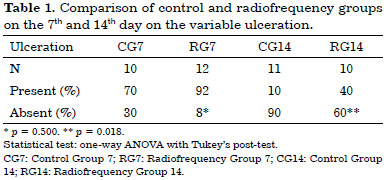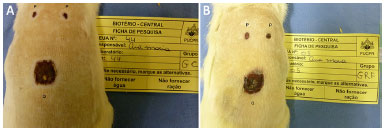ABSTRACT
INTRODUCTION: Given the extensive use of plastic surgery and the search for better aesthetic and functional results, it is necessary to research ways to improve healing and scarring. The objective is to evaluate the effects of three radiofrequency (RF) sessions in healing the skin of mice.
METHODS: Forty-eight rats were divided into four groups by day of sacrifice and treatment (RF group: RG; control group: CG). Dissection of the excisional wound of 2 cm x 2 cm (4 cm²) was performed and a 6-mm punch was used to hold two excisional wounds 0.6 cm in diameter. After 24 h, radiofrequency was performed using Spectra® directly on the wound in the dorsal region for 7 minutes at 38ºC. This was repeated three times on alternate days. For the control group, the radiofrequency protocol was performed with the device switched off.
RESULTS: A larger area of the square wound was measured on postoperative day three in RG (RG7: 3.3 cm² ± 0.7 cm² vs. CG7: 2.4 cm² ± 0.4 cm²; p = 0.009). On day 14, the square wound in RG was greater than in CG (RG14: 1.9 cm² ± 0.5 cm² vs. CG14: 1.0 cm² ± 0.3 cm²; p = 0.001). There was a 90% closure of wounds in CG14. In RG14, 60% of the wounds were re-epithelized while 40% remained ulcerated. In CG7, 70% of the remaining wounds were ulcerated and 30% were re-epithelized. In RG7, 8% were re-epithelized and 92% remained ulcerated.
CONCLUSION: Radiofrequency has a negative influence on the healing process, as indicated by mice that received radiofrequency having a persistent ulcerated wound.
Keywords:
Healing; Scar; Fibroblasts; Re-epithelialization.
RESUMO
INTRODUÇÃO: Tendo em vista o número de cirurgias plásticas e a busca por melhores resultados estético-funcionais fazem-se necessárias pesquisas para encontrar meios para melhorar a cicatrização e as cicatrizes. O objetivo é avaliar os efeitos de três sessões de radiofrequência na cicatrização da pele de ratos.
MÉTODOS: Quarenta e oito ratos machos foram divididos em quatro grupos conforme ao grupo que pertenciam e o dia do sacrifício (grupo radiofrequência - GR - e grupo controle - GC). Realizada a dissecação da ferida excisional de 2 cm x 2 cm (4 cm²) e utilizou-se um punch de 6 mm para a realização de duas feridas excisionais de 0,6 cm de diâmetro. Após 24 h, foi realizada a radiofrequência com o equipamento Spectra® na região dorsal, diretamente sobre as feridas por 7 minutos, com temperatura de 38ºC. Repetida por três vezes, em dias alternados. No grupo controle foi realizada com o aparelho desligado.
RESULTADOS: Foi encontrada área maior na ferida quadrada, no 3º dia pós-operatório do GR (GR7 3,3 cm² ± 0,7 cm² vs. GC7 2,4 cm² ± 0,4 cm², p = 0,009). No 14º dia a ferida quadrada do GR foi maior do que no GC (GR14 1,9 cm² ± 0,5 cm² vs. GC14 1,0 cm² ± 0,3 cm², p = 0,001). Houve fechamento de 90% das feridas no GC14. No GR14, 60% das feridas foram reepitelizadas enquanto 40% permaneceram ulceradas. No GC7, 70% das feridas de permaneceram ulceradas e 30% foram reepitelizadas. Já no GR7, 8%, foram reepitelizadas e 92% permaneceram ulceradas.
CONCLUSÃO: A radiofrequência tem influência negativa no processo cicatricial, mostrando que, nos ratos que receberam a radiofrequência, o quadrado permaneceu ulcerado.
Palavras-chave:
Cicatrização; Cicatriz; Fibroblastos; Reepitelização.















